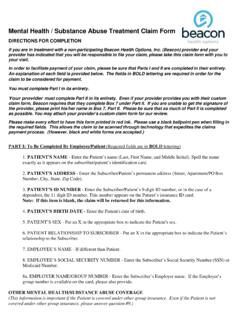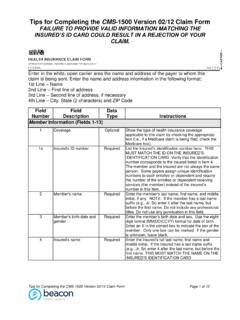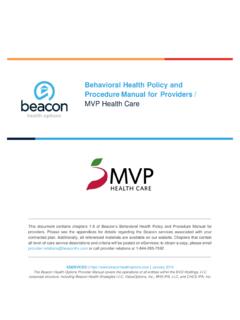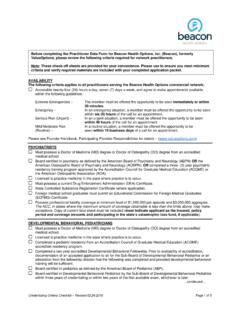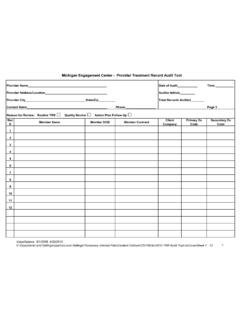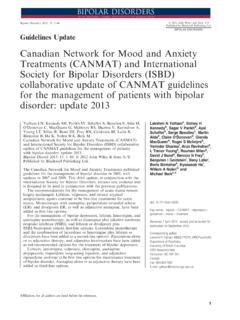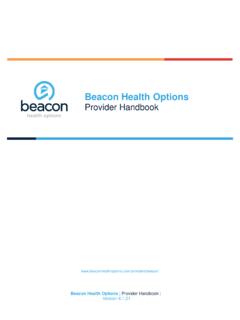Transcription of Clinical Treatment Record Review Form FINAL
1 Clinical Treatment Record Review Audit Tool Provider Name: _____ Discipline: _____. Practice Name: _____ Solo Group _____. Provider ID Number:_____. Provider Location: _____. Address: _____ Suite: _____. City: State: Zip: _____ _____ _____. Phone Number: _____ Fax Number: _____. Enrollee ID: Age: _____ _____. Diagnosis Code Primary:_____ Secondary:_____. Office Contact Name: _____. Verbal Summary of Treatment Record Audit Results Given To: _____. Was Compliance with Clinical Practice Guidelines Discussed? (check one): Yes No Reason for Review (please check one): Quality Review Action Plan Follow-up Routine Clinical Record Review Recredentialing Other Affected Account(s) _____ _____ _____ _____. C427C 1 of 7. Standard Yes No N/A Comments 1. Each page in the Treatment Record contains the enrollee's name or ID. number. 2. Each Treatment Record includes the enrollee's address, employer or school name, home telephone number, work telephone number, emergency contacts, marital status or legal status, appropriate consent forms, and guardianship information if relevant.
2 3. All entries in the Treatment Record include the responsible clinician's name, professional degree, and relevant identification number, if applicable. 4. All entries in the Treatment Record are dated. 5. The Treatment Record is legible to someone other than the writer. (A. second surveyor examines any Record judged to be illegible by one Clinical surveyor). 6. Relevant medical conditions are listed, prominently identified, and revised as appropriate in the Treatment Record . 7. Presenting problems, along with relevant psychological and social conditions affecting the enrollee's medical and psychiatric status, are documented in the Treatment Record . 8. Special status situations, such as imminent risk of harm, suicidal ideation, or elopement potential, are prominently noted, documented and revised in the Treatment Record in compliance with ValueOptions'.
3 Written protocols. 9. Allergies, adverse reactions or no known allergies are clearly documented in the Treatment Record . 10. A medical and psychiatric history is documented in the Treatment Record , including previous Treatment dates, provider identification, therapeutic interventions and responses, sources of Clinical data, relevant family information, results of laboratory tests, and consultation reports. 11. For enrollees 12 and older, documentation in the Treatment Record includes past and present use of cigarettes and alcohol, as well as illicit, prescribed, and over-the-counter drugs. N/A if the enrollee is under the age of twelve. 12. A mental status evaluation that includes the enrollee's affect, speech, mood, thought content, judgment, insight, attention, concentration, memory and impulse control is documented in the Treatment Record .
4 13. A DSM-IV/ICD9 diagnosis, consistent with the presenting problems, history, mental status examination, and/or other assessment data is documented in the Treatment Record . 2 of 7. Standard Yes No N/A Comments 14. Treatment plans are consistent with diagnoses and have both objective measurable goals and estimated time frames for goal attainment or problem resolution. 15. The focus of Treatment interventions is consistent with the Treatment plan goals and objectives. 16. Each Treatment Record indicates what medications have been prescribed, the dosages of each, and the dates of initial prescription or refills. For non-prescribing practitioners, each Treatment Record indicates what medications have been prescribed and the name of the prescriber. N/A is scored if medications are not prescribed. 17. Informed consent for medication and the enrollee's level of understanding is documented.
5 N/A if medication is not prescribed or the practitioner being reviewed is not a prescriber ( , MSW, PhD). 18. When medication is prescribed, there is evidence of consistency among the signs and symptoms, diagnosis, and medication prescribed. N/A is scored if medication is not prescribed or the practitioner being reviewed is not a prescriber ( MSW, PhD). 19. Progress notes describe enrollee strengths and limitations in achieving Treatment plan goals and objectives. 20. Enrollees who become homicidal, suicidal, or unable to conduct activities of daily living are promptly referred to the appropriate level of care . N/A is scored if the enrollee is not homicidal, suicidal, or unable to conduct activities of daily living. 21. The Treatment Record documents preventive services, as appropriate ( relapse prevention, stress management, wellness programs, lifestyle changes, and referrals to community resources).
6 22. The Treatment Record documents dates of follow-up appointments or, as appropriate, a discharge plan. 23. There is evidence that the Clinical assessment is culturally relevant ( addresses issues relevant to the enrollee's race, religion, ethnicity, age, gender, sexual orientation, level of education, socio-economic level, etc.). 24. There is evidence that the Treatment plan is culturally relevant. ( , addresses issues relevant to the enrollee's race, religion, ethnicity, age, gender, sexual orientation, level of education, socio-economic level, etc.). 25. There is evidence in the Record of coordination of care with the PCP or declination of this coordination by the enrollee. 26. The Treatment Record has evidence of continuity and coordination of care between behavioral healthcare institutions, ancillary providers and or consultants. 3 of 7.
7 Standard Yes No N/A Comments 27. The Treatment Record reflects evidence of coordination of care with other outpatient behavioral health practitioners 28. The Record reflects evidence of coordination with the EAP/employer if a referral was made. Child and Adolescent Records Only Items 29 33. 29. For children and adolescents, prenatal and perinatal events, along with a complete developmental history including physical, psychological, social, intellectual, and academic are documented in the Treatment Record . N/A if the enrollee is over the age of 18. 30. The Record reflects the active involvement of the family/primary caretakers in the assessment and Treatment of the enrollee, unless contraindicated. 31. The Record indicates the parent(s) or caretaker(s) have given signed consent for the various treatments provided. 32. The Record shows evidence of an assessment of school functioning.
8 33. The Record shows evidence of coordination with the youth's school to achieve school related Treatment goals Treatment Record -Based Adherence Indicators Score these items if the diagnosis for any case reviewed is in the 295, , , , , , , , or 314 series. Data related to these adherence indicators is used only in the aggregate it does not enter into the total score/evaluation of the records of this individual practitioner but the results are shared with the practitioner Major Depression or Series Yes No N/A. 34. Mood symptoms and suicidality are assessed at every visit 35. Co-morbid problems are assessed upon initial evaluation and at least annually. 36. When medication is prescribed, there is evidence of consistency among the signs and symptoms, diagnosis, and medication prescribed. N/A if medication is not prescribed or the practitioner being reviewed is not a prescriber ( MSW, PhD).
9 Schizophrenia 295 Series Yes No N/A. 37. There is evidence of an assessment of positive signs of psychosis, , delusions and/or hallucinations. 4 of 7. Standard Yes No N/A Comments 38. Co-morbid problems are assessed upon initial evaluation and at least annually 39. When medication is prescribed, there is evidence of consistency among the signs and symptoms, diagnosis, and medication prescribed. N/A if medication is not prescribed or the practitioner being reviewed is not a prescriber ( , MSW, PhD). 40. When anti-psychotic medications are prescribed, there is evidence of observation for side effects including EPS such as dystonic reactions, akathisia, ( can't sit still ), or akinesia. {Note: this applies to all discipline levels; N/A may not be checked). ADHD ; ; Yes No N/A. 41. The Record reflects the active involvement of the family/primary caretakers in the assessment and Treatment of the enrollee, unless contraindicated.}
10 N/A is scored if contraindicated. 42. Co-morbid problems are assessed upon initial evaluation and at least semi-annually. 43. The Record reflects education about ADHD and parent training in behavioral management. 44. When medication is prescribed, there is evidence of consistency among the signs and symptoms, diagnosis, and medication prescribed. N/A is scored if medication is not prescribed or the practitioner being reviewed is not a prescriber ( , MSW, PhD). 45. When medication is prescribed, there is evidence of an evaluation of the enrollee's response to medication and adjustments as needed. Bipolar Disorder , , , , , , Series Yes No N/A. 46. Mood symptoms and suicidality are assessed at every visit. 47. Co-morbid problems are assessed upon initial evaluation and at least annually. 48. When medications are prescribed that require serum level monitoring and/or laboratory tests to screen for medication side effects, those tests are conducted as recommended by the drug manufacturer.
